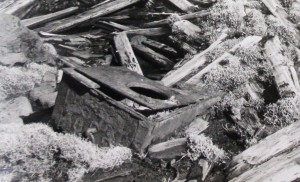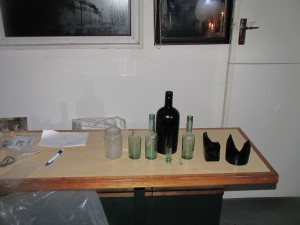When R.W. ‘Bob’ Rand, M8 biologist, became the first team member to walk round Marion Island during early November 1951 (over a five-day period on his own) he came across a small wooden hut with a corrugated iron roof at what was named on a 1952 map by fellow team member J.J. ‘Hannes’ La Grange as Mixed Pickle Cove. The well-constructed hut contained sealing equipment as well as canned and bottled food (including the eponymous mixed pickles) that was still edible and even a couple of “penny dreadful” romantic novels from the beginning of last century– as revealed by two photographs of its contents taken in 1954 by Sergeant W.J. Deysel of M11.


Names and dates carved on wooden planks found at the site revealed the hut was utilized over the period 1909 to 1921, probably by sealers arriving from Cape Town. Several team members in the 1950s had added their names to those of the sealers.
The hut’s comprehensive contents of equipment and canned and bottled food have all been taken away by team members over the years as souvenirs. By 1965 the hut had collapsed and a few half-buried planks, a coil of steel cable around a rock and glass and porcelain fragments are all that is left to be seen. The odd glass bottle is still spotted in hollows among the fur seals but following rules must now be left untouched.


An axe head (left of the rifle in the photograph shown here) and a number of glass bottles are the only items on view in the early photographs that have been saved for posterity. These items are now in the Iziko Museums of South Africa’s social history collection. What happened to the ceramic jars, the stove, the large pot, grinding stone and other items photographed by Louis Triegaardt (35) in 1978 is unknown but the anchor may well be the one now on display in the central hub of the new base. My own guess is that these bulky – and heavy –items had to be removed by helicopter and not on foot, probably in the early 1980s, as they were not visible when I first visited the site in 1984.


Souveniring of sealers’ artefacts at Marion Island robs all of us of an important aspect of South Africa’s Antarctic legacy and should never be condoned. Any disturbance of sealer’s sites and their contents without permit is specifically disallowed by the island group’s management plan.
With thanks to Jaco Boshoff, Brian Huntley, Louis Triegaardt, Eduard van Zinderen Bakker, Junior and Wilhelm Verwoerd for information and photographs.
Featured photograph: the Mixed Pickle Cove sealers’ hut, photo by Sergeant William John Deysel, 1954
Selected References:
Cooper, J. 2008. Human history. In: Chown, S.L. & Froneman, P.W. (Eds). The Prince Edward Islands: Land-Sea Interactions in a Changing Ecosystem. Stellenbosch: Sun PReSS. pp. 331-350.
La Grange, J.J. 1952. Sojourn on Marion Island. Newsletter Weather Bureau Weerburo Pretoria 39: 4-7.
Rand, R.W. undated. Report from biologist on trip to Marion Island. Pretoria: National Archives. HEN 3726 543/94 Vol. 2. 8 pp.
Rand, R.W. 1956. Notes on the Marion Island fur seal. Proceedings of the Zoological Society, London 126: 65-82.
John Cooper, Antarctic Legacy of South Africa, Department of Botany and Zoology, Stellenbosch University, 19 January 2016

